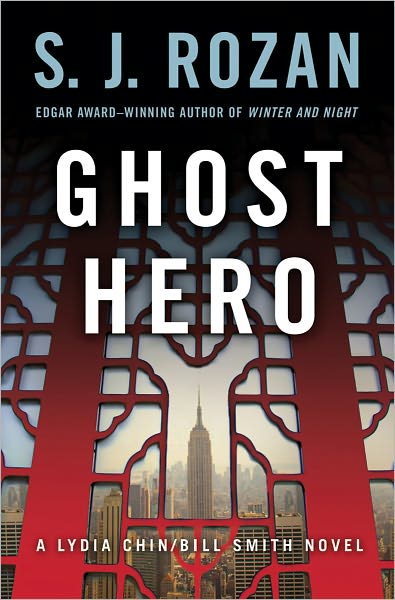
The cover of Ghost Hero (Image Source)
“He was a big deal professor, but he stood with the students. He died when the army came in. After he died, according to my client, he was a ghost, but a hero.” (20)5
“Ghost Hero,” published in 2011 and written by S.J. Rozan, is the 11th book in the Lydia Chin and Bill Smith mystery series. The series is told through books that alternate first-person perspectives of the two lead characters and detectives, and in this case the narrator is Lydia. Bill and Lydia are private investigators living and working in New York, with Lydia being the younger of the partners, still living with her mother in Chinatown.
The plot delves deep into the world of Chinese and Chinese-American art in New York, as Lydia follows a case given to her by a mysterious man going by the name of Jeff Dunbar, who wants her to discover the truth behind the rumors of new paintings by the “Ghost Hero.” This “Ghost Hero,” whose name was actually Chau Chun, was a Chinese artist known for his works’ hidden political commentary, and for dying in the Tianamen Square protests in 1989. Lydia and Bill must get to the bottom of this mystery, while also dealing with the fact that they are not the only ones on the case and the fact that Lydia’s client is also not who he appears to be. One of these other people on the hunt for the Chau paintings is Jack Lee, another American Born Chinese PI who becomes a fast friend and ally to Lydia.
This novel is a fun read, though not especially deep. The characters are compelling and enjoyable to read, especially newcomer Jack Lee, whose relationship with the two main investigators is one of the best parts of the book. The dialogue-heavy writing style lends itself well to allotting time for the characters to have conversations that not only move the story along but also develop the relationships between them, and show the reader different relationships between Lydia and Bill, Lydia and Jack, Lydia and her family, and others. The setting is also simply but successfully developed, and the restaurants and art galleries that the PIs visit seem as though they could be real places.
In the slanted sunlight I walked past cheap electronics stores, hawkers of bootleg purses and immigrants at sidewalk tables waiting to paint your name in bright brushstrokes and surround it with carp or dragons. (101)5
Lydia’s loyalty to her family and heritage and commitment to her job are endearing, as well as her tenacity and unwillingness to back down from the villains and danger of her case. She is very clever, as demonstrated through the fact that she is constantly realizing the secrets of those around her, but also knows when to reveal her knowledge or not in order to progress the case. Her flaws or awkwardness, such as her confusion as to her feelings for Jack Lee only endear her to the readers further, and draw them into both this novel and the series as a whole. Though it is a “Lydia Chin and Bill Smith Novel,” it is clearly far and away Lydia’s book, as Bill spends most of the novel busy assuming the persona of Oblomov the Russian mobster.
Ghost Hero fits neatly into the hard-boiled subgenre, though it does diverge from this tradition in some ways that make it more similar to a cozy. There is a constant thread of humor throughout the novel, which leads to a much lighter tone than many hard-boiled mysteries, though not all, as other authors like Robert B Parker are known for their humor. It also has a much smaller focus on violence than many other novels in the tradition do. Though not void of any of this content, there are no on-page deaths and most of the issues are solved through conversation, disguises, or trickery. It also focuses on a pair of private investigators, not a loner, and allows Lydia to have emotions, a personal life, a family, one that even comes in handy for helping to solve the case.

A Chinese Brush Painting (Image Source)
The book is not stylistically very complex, and is comprised primarily of dialogue between characters. This allows the story to move along quickly, and lets the reader complete the book in a shorter amount of time than might be expected given the length. Depending on reading speed, the novel is able to be completed within one to four days. The first person point of view also lends itself to occasional stream-of-consciousness musings from Lydia, which leads to a fast pace and humor, and is also appropriate given her close relationship to the Chinese-American world being explored.
It is also noteworthy that this novel stars an Asian-American woman as the private eye, since detective fiction as a genre can often be lacking in diversity. As the main plot is focused around Chinese art and how it interacts with Chinese politics, many of the other characters are Chinese or Chinese-American as well. The cultural aspects that S.J. Rozan depicts do appear to be well-researched, and she even includes a guide to Chinese art on her website.4 It should be noted, however, that S.J. Rozan is not Asian and occasionally does drift into depictions of her side characters that could be seen as stereotypical, such as Lydia’s “Tiger Mom.” Different critics have very different views of this issue, as Reddy states that the Lydia and Bill novels “demonstrate a deep-seated attachment to white authority and a resistance to undermining that authority,” (165)3, while Fischer-Hornug and Mueller instead see these novels as “increasing empowerment of Asian Americans” (51)1. There is also a side character, Eddie To, who has a husband off-screen, though he avoids falling solely into stereotypes of gay men and this is not the only aspect to his character. The political nature of the novel is fascinating as well, and S.J. Rozan herself views the political commentary as one of the major themes. For a period of time in 2011 when the novel was first released, Rozan donated a portion of each sale to Amnesty International, in order to make an additional commentary on China’s habit of imprisoning dissidents.4
The artists who get in trouble are the ones who don’t keep their mouths shut. The ones who let their work do the talking are pretty safe.” (4)5
The book is generally well-received, with a 3.79 average star rating on Goodreads, and it was a winner of the 2012 Dilys Award2. It is the eleventh and most recent novel in the Lydia and Bill series, though there were a few short stories released in 2012 and 2013, and it is unclear if Rozan intends to continue the series with any more novels.

The author, S.J. Rozan (Image Source)
About the Author:
Shira Judith Rozan, born 1950, is a lifelong resident of New York and has published 15 novels, 11 of which star Lydia and Bill, as well as many short stories. She writes under both her own name, abbreviated S.J. Rozan, and as Sam Cabot when cowriting with Carlos Dews. Her work as an author has won her several awards, including the Edgar Award, and has been known to speak at events schools. She also has a background in photography and architecture.4
Final Verdict: 4/5 Stars
![]()
While the style is nothing special, it does make the book very fast-paced and both enjoyable and thrilling to read. Some aspects did seem slightly stereotypical or predictable, but this did not detract too heavily from the novel as a whole. Having been published only a few years ago, it still reads as very modern, though a reference to Myspace does date it a bit on its own. The characters and the ending were the strongest parts of the book, saving it from what could be a mediocre 3 or 3.5 rating and propelling it to a solid 4 stars. Overall, highly recommended for fans of the genre looking for a quick, fun read.
References and Additional Resources
- Fischer-Hornung, Dorothea, and Monika Mueller. Sleuthing Ethnicity: the Detective in Multiethnic Crime Fiction. Assoc. Univ. Presses, 2003.
- “Ghost Hero (Lydia Chin & Bill Smith, #11).” Ghost Hero (Lydia Chin & Bill Smith, #11) by S.J. Rozan, Goodreads, www.goodreads.com/book/show/10866347-ghost-hero.
- Reddy, Maureen T. Traces, Codes, and Clues: Reading Race in Crime Fiction. Rutgers University Press, 2003.
- Rozan, S. J. “Award-Winning Author S.J. Rozan.” SJ Rozan, 2013, sjrozan.net/.
- Rozan, S.J. Ghost Hero. Minotaur Books, 2011.
